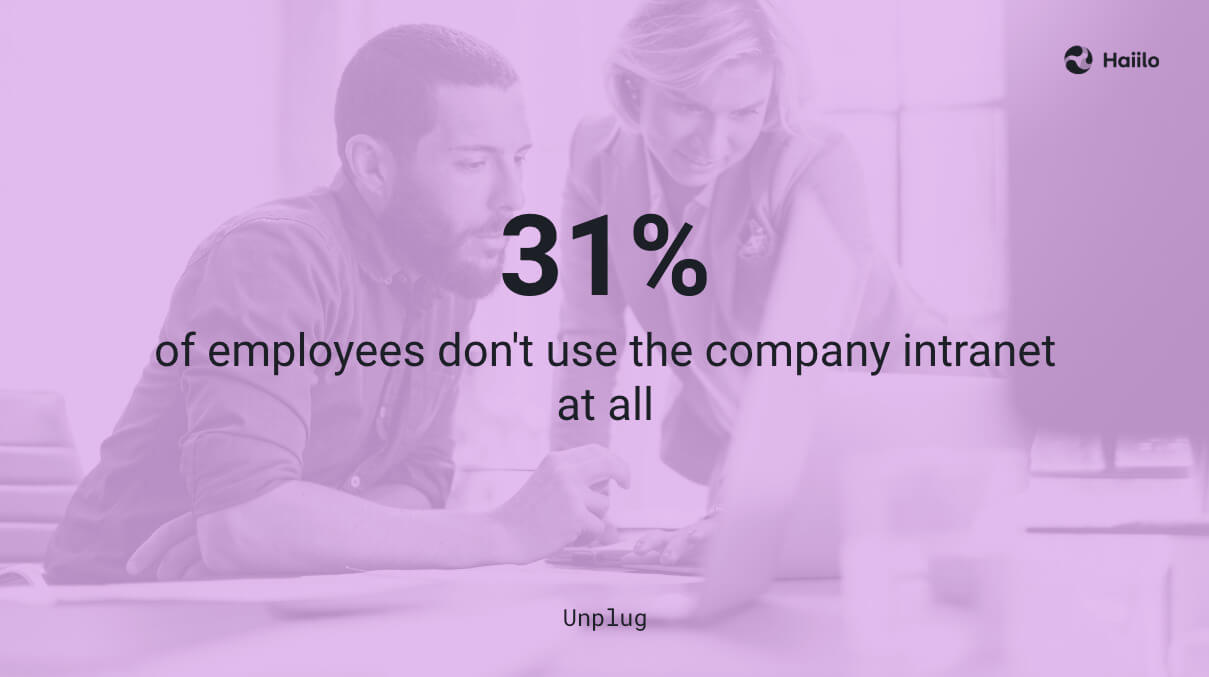Should enterprise companies buy or build an intranet? Even though there are dozens of out-of-the-box platforms available on the market, this is still a question that deserves attention and clarity.
Since intranet is often the core solution within every digital workplace, some employers tend to take the route of building a 100% custom solution to accommodate every single unique need that they have.
Is this a good approach? While ready-made intranets may not fulfill the unique needs of every large enterprise out there, the reasons why go buy vs build are undeniable. Organizations need to assess whether there’s already a suitable solution out there or a solution that offers sufficient adaptability with a little bit of tweaking and configuration.
According to research, on average, large IT projects run 45% over budget and 7% over time, while delivering 56% less value than predicted. Software projects run the highest risk of cost and schedule overruns. So the real question is: Are you ready to take these risks and build your homegrown intranet?
Let’s dig deeper into why you should buy, and not build, an intranet for your organization.
💡 Related: Check out our step-by-step guide for launching an intranet platform!
1. Hidden Costs
When you are buying an intranet, you know exactly what you get and how much it costs. On the other hand, building an intranet from scratch usually comes with a lot of hidden, unanticipated expenses.

Because intranets are quite complex workplace solutions, it is almost impossible to budget the development correctly, without missing any hidden costs that may appear.
So it’s not uncommon that custom-built intranet projects give rise to unpredictable costs as they require ongoing development, typically from third-party developers and IT experts.
On the other hand, buying an existing cloud solution comes with predictable costs and offers everything an organization needs to host, test, launch, maintain, optimize, and scale the platform. As nicely put in Gartner’s Market Guide on intranets:
Organizations now require cloud-based, agile platforms, which give them the flexibility they need to improve employee experiences.
Save on your intranet project with Haiilo!
2. Time to Value
Intranet vendors usually have dozens or hundreds of employees devoted to building a solution that best fits the market needs, and they have been doing that for years or even decades.
So another important consideration in the build or buy intranet debate is that building a custom solution such as SharePoint, can, according to Nielsen Norman, take at least fourteen months (sometimes even years), with a commensurately slower time to value.
However, when companies realize a need for a solution such as an intranet, very few can afford to wait for months until implementation.
On the other hand, ready-made intranet platforms can be implemented within days or weeks, depending on the company size.
3. Focus, Technical Knowledge, and Field Expertise
Building an intranet in-house is very likely not your business’ main focus. And lack of focus is the major reason why software projects end up with significant cost overruns, as nicely pictured in the image by McKensey below.

Next, technical complexity, lack of skills, and unaligned teams commonly result in poor software performance.
In other words, an inability to master the first two dimensions typically causes about half of all cost overruns, while poor performance on the second two dimensions accounts for an additional 40% of overspending.
When choosing an existing intranet platform, you are avoiding the risks of failure and significant additional and unexpected costs. These companies usually have a big team of IT and internal comms experts who know about intranet best practices and are designated to the sole goal of making their solution more valuable to their customers. Some even offer professional services and consulting hours to help their clients get the biggest possible ROI for their new intranet investment.
4. User Adoption and Onboarding
The best social intranets can serve as a centralized portal for internal communication, employee engagement, onboarding, feedback, and business processes, but they won’t be successful with low end-user adoption. In the average organization, 31% of employees don’t use the company intranet at all, according to Enplug, which makes it difficult to leverage the benefits of an intranet.
Historically, intranets are seen as the least user-friendly workplace solutions, resulting in quite poor user adoption. And this is the main reason why intranet projects fail.
Successful off-the-shelf intranets, on the other hand, are unlikely to succeed with poor user interface and low engagement from end users.
Furthermore, ready-made solutions don’t require technical skills from employees to be onboarded successfully and get familiar with the platform. Homegrown intranets, on the other hand, may require more technical skills and knowledge from employees. Therefore, out-of-the-box solutions have higher chances of adoption, which increases not only the engagement with the content on the intranet, but the overall engagement within the company.

So when deciding to build or buy an intranet, make sure that you understand the complexity behind making the platform intuitive, engaging, and user-friendly. If you want to avoid the risks of low adoption rates, you may be better off going with an existing solution that was built with engagement metrics in mind.
Also, when evaluating existing providers on the market, make sure they don’t have a reputation for low user adoption. For example, many companies use Microsoft’s SharePoint just because it comes with the full Office package. However, it is well known that SharePoint has been struggling to reach high user engagement rates in enterprises. Furthermore, SharePoint does not provide a great experience for mobile users, making it a poor solution for companies dealing with frontline workers.

5. Security and Compliance
Intranets are the central place for sharing workplace information and documents, even the most sensitive ones. So security and compliance with strict regulations should be on top of every intranet builder’s mind.
Luckily, existing solutions such as Haiilo come with ISO 27001 certifications as well as support GDPR compliance which is an absolute must-have for countries in the European Union.
If you decide to buy an intranet, make sure that you choose a vendor that performs regular penetration tests and checkups for potential vulnerabilities. Make sure that data encryption is offered both in transit and at rest. Some of the existing vendors also offer a designated DPO (Data Protection Officer) so you don’t need to hire one in-house.
Furthermore, if hosting location is important for your organization, know that some vendors recognize the adherence to their clients’ compliance standards and offer both US and EU hosting options.
Also, if your homegrown platform doesn’t turn out to be user-friendly and suffers low user adoption, you have to take into consideration that people will turn to other tools to share sensitive workplace information and materials, putting your company at risk of serious data breaches.
6. Integrations
U.S. employees change through an average of 13 apps 30 times per day, according to Asana’s Anatomy of Work Index 2021 report. And 26% of surveyed employees say app overload makes them less efficient at work. So integrating your intranet with other tools employees use is critical.
One may think that when it comes to integrations, building an intranet would make more sense than buying it; you can just build integrations based on your company’s specific needs.
However, good integrations take a lot of time and resources.
Off-the-shelf solutions come with pre-built native integrations with the most popular workplace technology on the market, which provides flexibility to shape your platform the way you want. They also offer open APIs if you need custom integrations. Some may even go a step further and influence their product roadmaps based on your integration needs. Hence, before deciding to go this route in-house, consider evaluating existing intranet platforms.

7. Scalability and Product Roadmap
If you are considering building an intranet in-house, it is important to understand that the job is not done with the launch.
Building an intranet allows you to customize the platform to meet your organization’s specific needs, but it also means you need to monitor, maintain, and update it constantly. Homegrown intranets need a designated in-house IT team, or expensive 3rd party contractors, whose job becomes even more complex and more expensive as your company grows.
Furthermore, the intranet you build today probably won’t be as suitable for your company and your employees tomorrow. A small change in business processes may require a completely new setup within the platform, which is always harder to achieve with custom-made solutions than with a flexible out-of-the-shelf platform. For example, you may need to add a large number of new users, database entries, or other performance-related improvements. You may need to add new features, screens, compliance functionalities, and other adjustments that can easily create significant additional expenses.
So it’s important to account for scalability when thinking about whether to build vs buy software and consider those vendors who have great support, are constantly investing in their product roadmaps, and can scale with you as your company grows and as your needs change.
8. Additional Built-In Features and Functionalities
Last but not least, buying an intranet may be a better option than building it because some intranet vendors come with additional, nice-to-have, features and functionalities making the solution a more comprehensive employee experience platform.
For example, Haiilo comes with powerful built-in modules for employee advocacy and employee engagement surveys. The best thing is that all of these are available within a single platform, making the tools easier to access and data to have more sense.
Last but not least, some vendors are more advanced in using AI to make their intranets even more efficient, smarter, and easier to use.
Doing all of this in-house would, again, take another few years of development and more professionals to make it happen.










